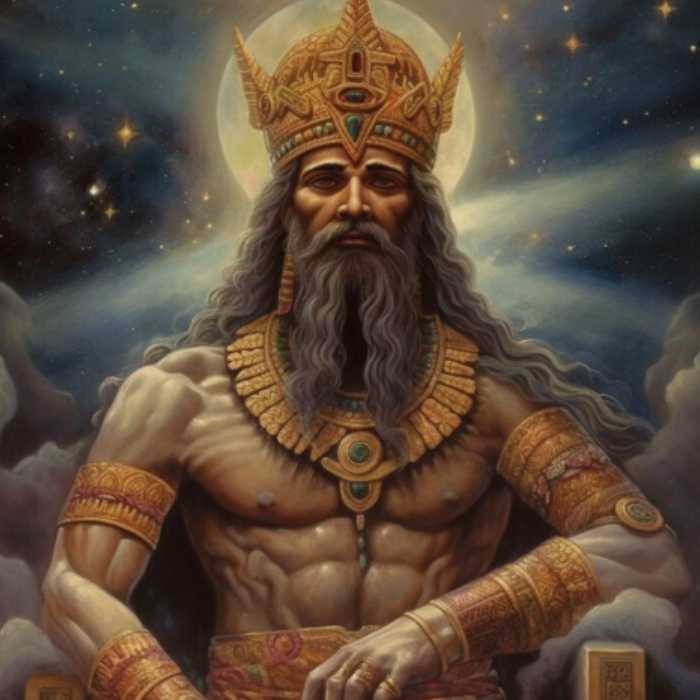An (Anu)
An, also known as Anu in Akkadian, was the supreme sky god in the Sumerian pantheon, representing the heavens and celestial realm. As the father of many gods, including Enlil, Enki, and Ninhursag, An held the highest authority and played a central role in the mythology and genealogy of Sumerian deities.
Revered throughout ancient Sumer and associated with the city of Uruk, An's worship laid the foundation for Sumerian religious beliefs. His influence continued in the Babylonian and Assyrian pantheons as Anu.


Name and epithets:
- An (Sumerian)
- Anu (Akkadian)
Role and associations
- Sky god
- The supreme deity in the Sumerian pantheon
- Represents the heavens and celestial realm
Iconography and symbols:
- Often depicted as a bearded, human-like figure
- Wears a horned headdress, symbolizing divinity
- Associated with celestial imagery, such as stars, clouds, and the sky
Origin and family:
- One of the earliest gods in the Sumerian pantheon
- Father of many gods, including Enlil, Enki, and Ninhursag

Cultural significance and influence:
- A was the highest authority in the Sumerian pantheon, and his worship formed the foundation of Sumerian religious beliefs
- As the father of many gods, An played a central role in the mythology and genealogy of the Sumerian deities
- Anu, the Akkadian version of An, remained an important god in the Babylonian and Assyrian pantheons, demonstrating the lasting influence of the sky god in Mesopotamian mythology.
Worship and cult centers:
- Associated with the city of Uruk
- Revered throughout Sumer as the supreme deity
Key myths and stories:
- Involved in the Eridu Genesis, the Sumerian creation myth
- Appears in the myth of Inanna and Enki, where he grants Inanna the sacred "me" (divine powers and attributes)
- Father of many gods, who inherit various roles and responsibilities in the world
An's role in Sumerian Mythology
An, also known as Anu in Akkadian, was the supreme sky god in the Sumerian pantheon. His primary role was to represent the heavens and the celestial realm, acting as the overarching authority among the gods. As the highest deity, An was considered the divine source of authority for other gods, who often sought his approval or guidance in matters related to their respective domains.
An was associated with the celestial sphere, including the stars, the sky, and the vast expanse of the universe. His position as the sky god linked him with the forces of nature, order, and cosmic balance. Due to his status as the supreme deity, he was often invoked in prayers, hymns, and rituals to provide blessings, protection, and guidance.
An was also seen as a distant and somewhat enigmatic figure, with his influence mainly felt through his offspring, who played more active roles in the daily lives of the Sumerians. Some of these gods included Enlil, the god of wind and storms, Enki, the god of water and wisdom, and Inanna, the goddess of love and war. As the father of these gods, An played a crucial role in the structure of the Sumerian pantheon, establishing the divine hierarchy and the relationships between the gods.
Astral role
In Mesopotamian astronomy, the sky was divided into three zones or "Ways," each associated with a specific deity. Anu's domain encompassed the stars located between the other two zones, which were assigned to Enlil (stars closest to the pole) and Ea (stars close to the equator). This division is best attested in the ancient astronomical treatise MUL.APIN, which was composed sometime after the Old Babylonian period. The boundaries of each Way were assumed by astronomer John G. Rogers to be at 17°N and 17°S.
The concept of the tripartite division of the sky is referenced in a 13th-century BCE document, a version of the so-called Prayer to the Gods of the Night. However, the oldest copies of this text do not mention the division yet.
During the Seleucid period in Uruk, Anu's astral role expanded, and by 216/215 BCE, he was described as being responsible for the entire firmament. Additionally, two circumpolar stars began to be referred to as the "Great Anu and Antu of Heaven," and they received offerings as though they were deities themselves. These stars appeared alongside the other seven major celestial bodies known to Mesopotamian astronomers in the late first millennium BCE: the Sun, the Moon, and the planets Nebēru (Jupiter), Dilbat (Venus), Šiḫṭu (Mercury), Kayamānu (Saturn), and Ṣalbatānu (Mars).
